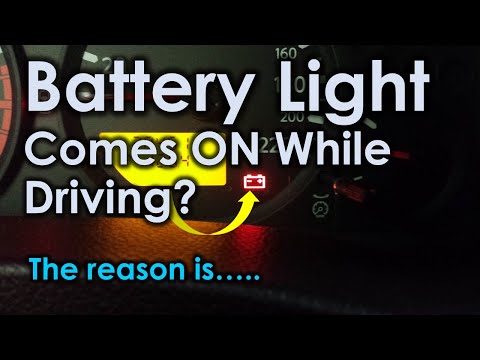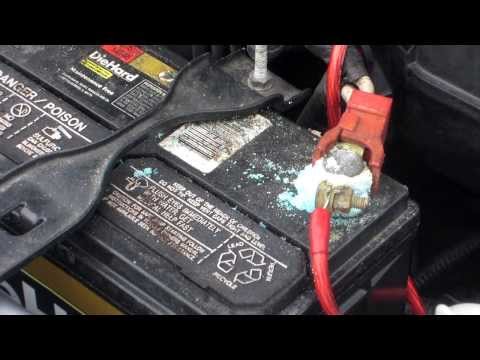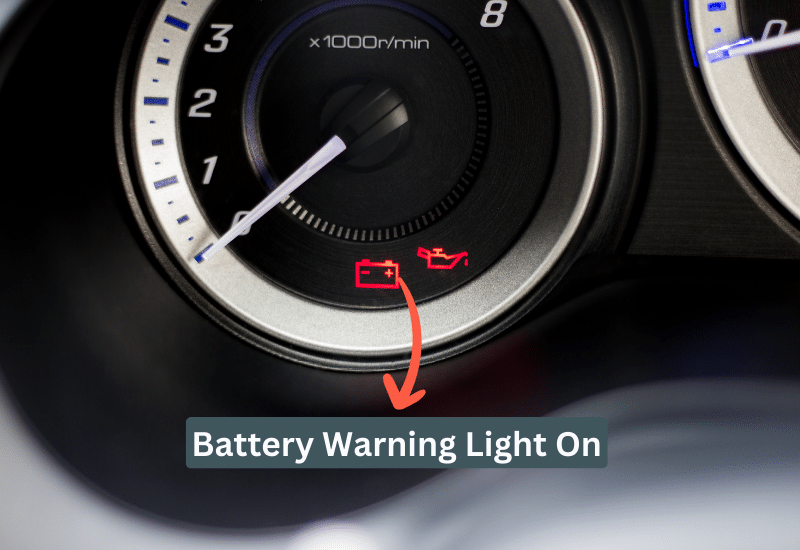
A red battery light is one of those warning indicators that just about any car has on its dashboard. It will illuminate when there is an electrical issue with the vehicle. Although this may seem dramatic, your car could run fine when the red battery light pops up. If that’s the case, you’re likely to have several questions going through your head.
First, why has this happened, and what should I do? Or can I drive my car if the red battery light is on? And if so, for how long can I use it like this before something else goes wrong? To answer these questions, you must understand what the red battery light warning means and what may cause it. So, let’s dive right into the subject at hand.
What Does the Battery Light on the Dashboard Mean?
You probably already know that the car’s electrical system uses a 12-volt direct current. But you might be unaware this is in theory only, with actual values differing slightly.
First, we have the battery, which, if healthy and fully charged, should hold approximately 12.5 volts. Besides providing electricity for the starter motor when turning on the engine, this also powers up various electrical systems when the car is off.
Then, we have the alternator, which generates electrical charge while the engine runs. Its output varies between 13.5 and 15 volts, depending on the engine speed and electrical loads. This charge is used to top up the battery and power the car’s electrical systems.
If, for any reason, the charge level drops below 13 volts while the engine is on, the red battery light will pop up on its dashboard. But even when that happens, your car may seem to run fine and have no other symptoms. This is because its electrical system is now running using the charge stored in the battery.
But the battery’s capacity is limited, so driving like that will drain it quickly. And when that happens, your car will stop, leaving you strained at the side of the road. Moreover, discharging the battery so deeply may cause permanent and irreversible damage, leading to additional repair expenses.
7 Possible Causes of Car Battery Light On While Car Runs Fine
To find out what’s causing the red battery light to stay on, you first must know what to look for. And to help you with this, I’ve compiled a list of probable causes, with a short explanation for each.
1. Faulty alternator
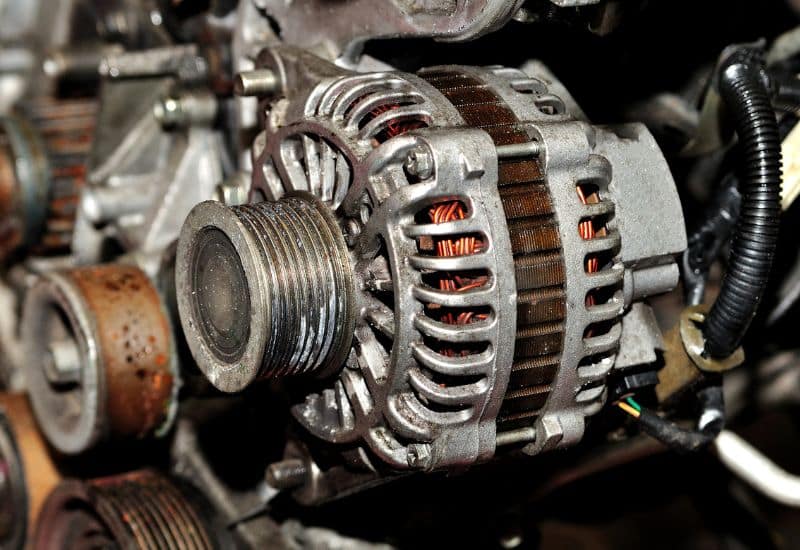
The infamous red battery light flashing on your dashboard primarily indicates potential issues with your vehicle’s alternator. The alternator could fail due to various reasons, including mechanical wear or damage to its essential moving components such as the rotor, slip ring, and brushes. Additionally, electrical issues caused by a faulty rectifier or voltage regulator could also be the culprit. As a result, the alternator may not be able to generate sufficient charge, or in some cases, any charge at all.
2. Slipping The alternator pulley
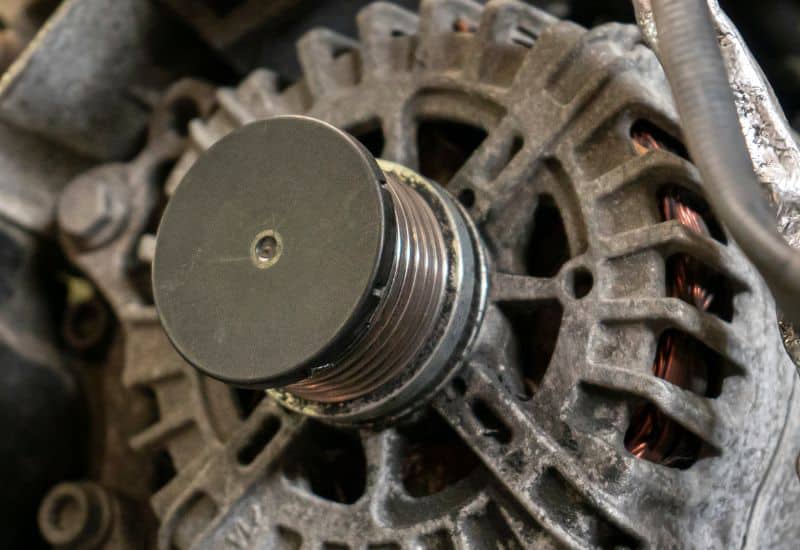
The alternators in most modern cars have a pulley with an integrated clutch mechanism inside it. It effectively disconnects the alternator from the aux belt when no charging is needed and slightly improves fuel economy. But such a pulley may get stuck in a disconnected position, and the alternator will lose its drive. This disruption leads to a decline in battery charge, which in turn triggers the activation of the red battery light on your dashboard.
3. Damaged battery
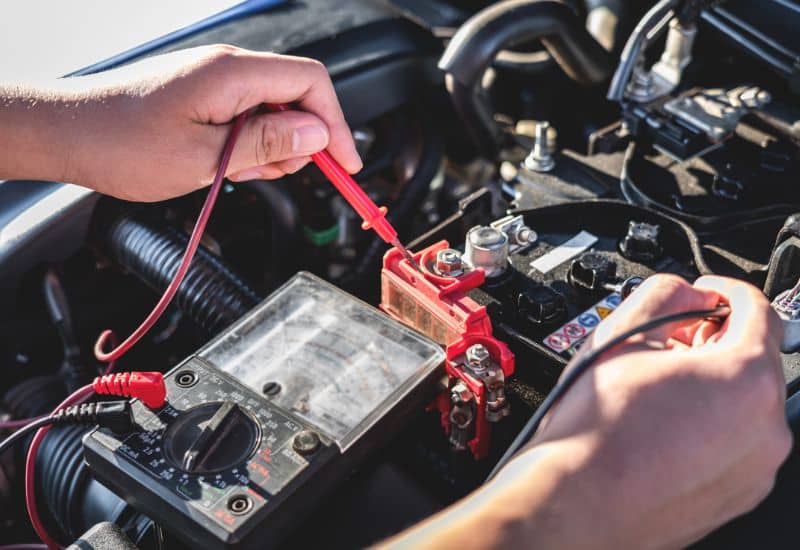
The battery, even if worn or flat, will rarely cause this warning light to come on, despite the symbol suggesting so. But if it’s been fully discharged in the past, one or more cells inside it might’ve warped, which creates an internal electrical short. And if that has happened, the battery will not be able to take sufficient charge and will have to be replaced. In addition, if you have a traditional, wet-cell battery, it might be low on acid, and topping it up with distilled water might solve the problem.
4. Corrosion on battery terminals
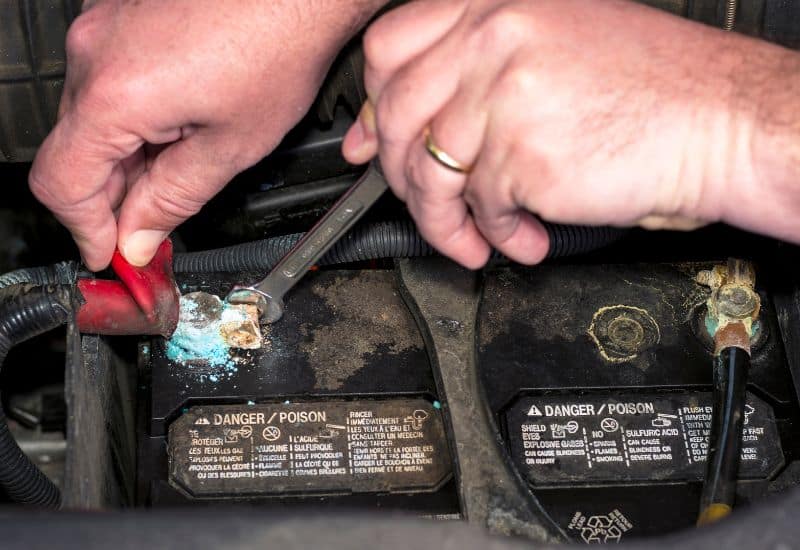
Another potential battery-related problem that could prompt the battery light to illuminate is corrosion on its terminal, which usually appears because of overcharging or acid leaks. If substantial enough, these whitish, powder-like buildups will increase the resistance between the battery terminals and lead clamps, consequently obstructing electric flow. Luckily, corrosion can be easily cleaned off with warm water and baking soda. Loose cable clamps will have a similar effect, which predictably will be solved by tightening them up.
5. Wiring issues
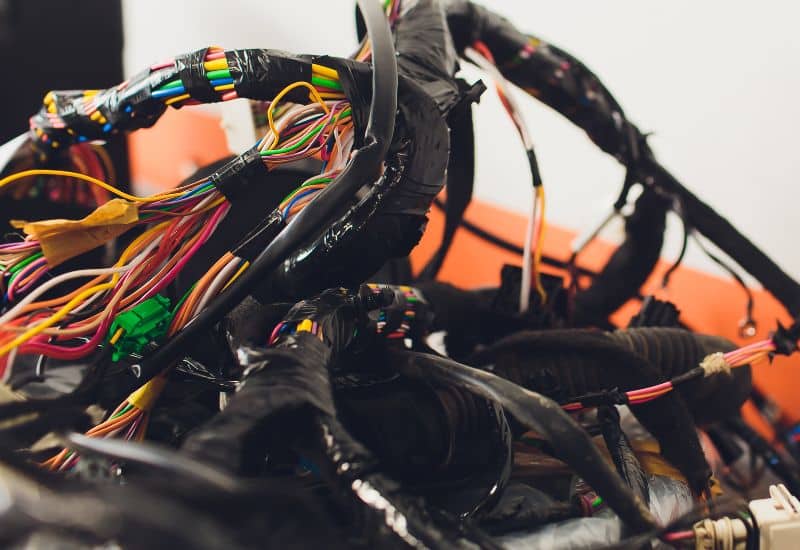
Any damage to the wires that connect the alternator and battery to the rest of your car’s electrical system can disrupt the charging system and prompt the battery light to activate. Similarly, if wire connectors become loose, akin to the lead clamps, you might experience the same issue.
To address this, an immediate inspection of the two main grounding strips is recommended. One of these strips links the engine to the chassis while the other is connected to the battery. Another typical point of failure that demands attention is the thick red wire that runs from the alternator to the battery.
6. Broken dashboard wire
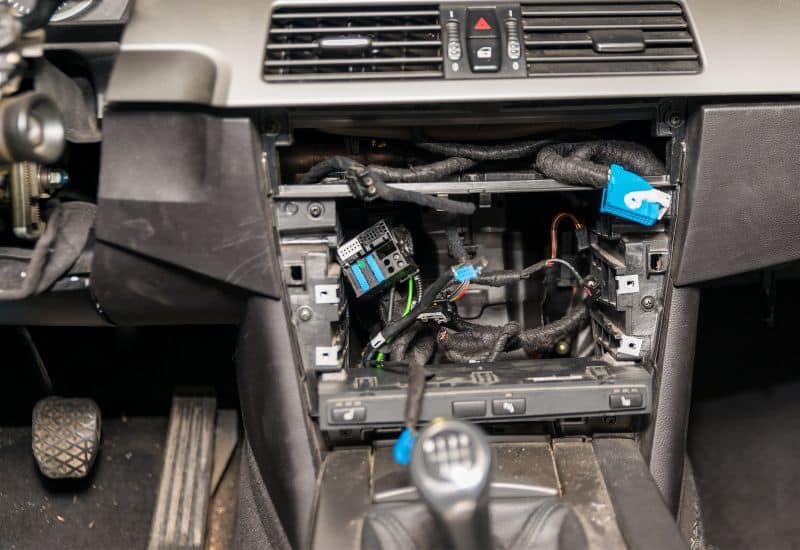
Most cars have a wire running from the alternator to the ECM or the dashboard, through which the signal about the charge level goes. Because it’s usually made from thin cable, this wire might get physically damaged or corroded. This causes false readings, which trick the EMC into thinking there’s something wrong with the charging system and triggering the light.
7. Broken or loose aux belt
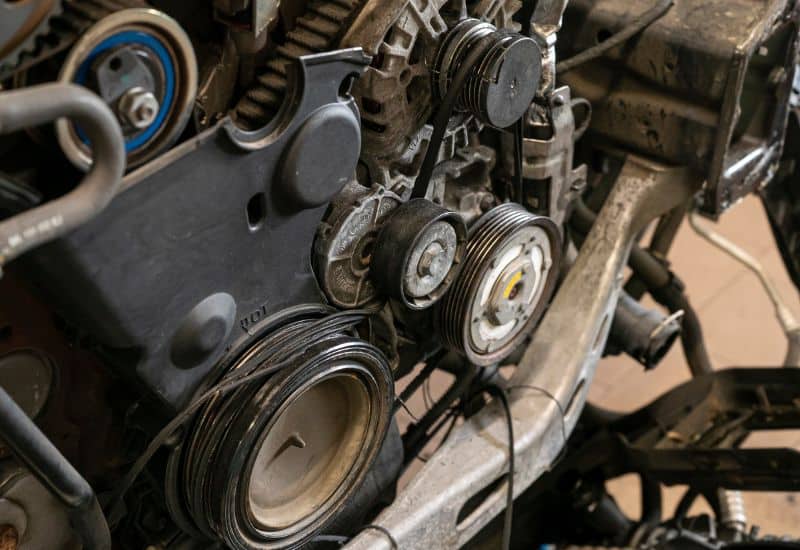
Lastly, we have the auxiliary or serpentine belt, which drives the alternator and several other components. Depending on the model, this can include the coolant pump, AC compressor, and power steering pump. And if the belt is loose or snaps, all of these will be out of action, will cease to function, often leading to the battery light illuminating. You may also notice that the steering becomes stiff, or the air conditioning ceases to work. However, keep in mind that some cars have electric power steering, which will continue to operate in this situation. Furthermore, if it’s chilly outside, your air conditioning would naturally be turned off, making it less noticeable.
What To Do If Your Car Battery Light Comes On While Driving?
When you turn on the car, the battery light will stay on for a second or two before turning off. This is perfectly normal, as that’s how long it takes for the alternator to start charging the electrics. And if it doesn’t go off, shut down the car, as some of the above has probably gone wrong.
But what if the red battery light pops up while driving down the road? For starters, slow down and look for the first convenient place to pull over. Just make sure it’s safe, with no risk of being hit by oncoming traffic.
Once stopped, turn off the engine, engage the parking brake, turn on the hazard lights, and pop the hood. Obviously, you aren’t going to solve an issue with a malfunctioning alternator at the side of the road. But still, plenty of other things can be checked and even fixed, assuming you know what to look for.
What can easily be checked when the battery light is on?
The first thing you want to do inside the engine bay is to look for anything unusual, starting with the aux belt. It should be neatly wrapped around all pulleys and feel firm when you press it.
Next, check the battery and its terminals, which shouldn’t be covered with thick layers of corrosion. While at it, wiggle both positive and negative cables to see if they are loose. And do the same with the positive cable that connects the battery and the alternator.
Any investigation beyond this point will require some tools, such as sockets and a multimeter, which you’re not likely to have in your trunk. In that case, towing the car to your home or workshop will be the only option.
Driving with the battery light on
If the battery light has come on just a few miles from your house, you might drive your car there instead of having it towed. If it’s in good shape, the battery should have enough charge to keep the engine going for 10 to 15 minutes at least.
But while driving, turn on any unnecessary consumers, such as the air-con or heaters. The same goes for the headlights, assuming the battery light popped up during day time. All this should prevent the battery from being drained excessively.
Testing the battery and alternator in your car
Because several things can trigger the red battery light, figuring out which component is to blame can be difficult. Still, you can narrow down the problem using a digital multimeter and the following procedure.
Depending on these results, you can determine which of these two components is causing the issue. If the battery is still not holding voltage even after being hooked to a charger, it must be replaced. On the other hand, if there’s no change in voltage at the battery’s terminals when the engine is on, the alternator is likely dead.
Cleaning off the corrosion from the battery’s terminals
As said, one of the things that may trigger the battery warning light is corrosion buildups on the battery’s terminals. Luckily, this is easy to spot and even easier to clean off.
Frequently Asked Questions
Is It Safe To Drive With My Battery Light On?
Although the car might run even when the battery light is on, driving it like that is not safe or recommendable. If the alternator is faulty, the battery will not get charged and will eventually go flat. Similar might happen if the wiring is damaged or the claps are loose or corroded. The situation is even worse if the aux belt has snapped, as this could put the coolant pump out of action, which will cause the engine to overheat. All this may damage various vehicle components, making consequent repairs much more expensive.
How long can I drive my car with the battery light on?
Assuming the battery light is triggered by a charging issue, such as a broken alternator, your car’s electrical system will be running using the power from the battery. And how long it will take until it goes flat depends on its capacity and condition. But in most cases, you can expect it to keep your car going for 10 to 20 minutes until its engine cuts out. And to make the best of the charge you have left in your battery, turn off all unnecessary electric consumers, such as various heaters and air-con.
How can you tell if it’s the alternator or the battery?
One way to determine if the battery or the alternator is causing the problem is by paying attention to symptoms. With a dead or worn battery, the engine starter will not engage when you turn the key. But if you jump-start your car, it will run fine, assuming there are no other charging system issues.
On the other hand, if the alternator is broken, the engine might start, but the battery light will stay on afterward. Another option is to measure the voltages between the battery’s terminals, which should be 12.5 volts with the engine off and approximately 14 volts when the car is running.
Why is the battery light on after replacing the battery?
If the red battery light is still on after installing the new battery, you likely have a charging system issue. This could be caused by anything from a faulty alternator or voltage regulator, if this is a separate part, to damaged or loose wiring. Blaming the battery instead of checking all these components first is a common mistake many car owners make. This is why it’s always vital to carry out a thorough diagnosis before replacing any parts.
Car Battery Light On, No Worries
A red battery light is a warning sign indicating a problem with your car’s charging system. It can stay on after you’ve turned on the engine or suddenly pop up while driving down the road. And even if your car is running fine when this happens, this warning mustn’t be ignored, as its engine might cut out in a few minutes. Some things that can trigger the battery light are a broken alternator, a faulty battery, and wiring issues. You can check everything visually or measure the voltages on the battery’s terminals with a multimeter.

Written By
Victor Faeda
Victor is a Mechanical Engineer BSc and certified Automotive Mechatronics technician from Portugal. He worked as an intern mechanic for Volvo and has been fixing his own vehicles for over 10 years. Writing and cars are his passion, so now he combines the two by creating content around the automotive industry. He specializes in automotive technology and maintenance.

